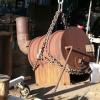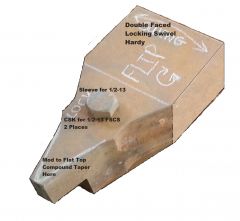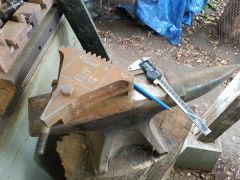-
Posts
1,746 -
Joined
-
Last visited
Content Type
Profiles
Forums
Articles
Gallery
Downloads
Events
Everything posted by Anachronist58
-
Gergely, just a thought - My 1934 South Bend was originally an overhead-drive machine - I converted it to a rear-mounted underhand drive......Just a thought..... Robert Taylor
-
Looked at Pics in the Gallery. Frosty, that anvil is marked Dannemora (for the Dannemora Mining District?) My 88# Soderfors Paragon I so heavily dented that there should be an arrest warrant out for somebody. And yes, the edges are definitely hard enough to chip, and someone saw to that also, in spades. I have not been able to dent it myself while forging, or cold working 11018 welding electrode, But I have dented it in a test with a ball peen hammer, and a 15-5 PH rod. Dabsterinn, your image of the face is a bit blurred, so please try to get another shot. Looks to me like you have Plenty of sweet spot. Rough in over the rough, and finish in the smooth.
-
-
What is the average weight of the hammers in that video? Two pounds, three pounds? I was cold straightening a well-bent 1/2" diameter 'U' bolt off of a leaf spring shackle the other day. First I put it under my 3 ton rack and pinion press. Put all of my 220# on the 'legal' lever. Did not even flex. Took it over to my Hubs of Hades anvil and gave it a short, sharp rap with the broad face of my short handled (9-1/2") 3# Cross Peen hammer. The metal moved with ease. Finished it out. I don't know how much force that hammer blow delivered, but didn't it have to exceed three tons? My command of mathematics is poor, otherwise, I would not now have more questions than answers. I believe though, after watching the preceding video, and from my own experience, Acceleration is King. I have hand split dozens of cords of oak, et cetera, in my lifetime, and it's just something you know (well I think I know). One of the other things I have been noticing in these competitions is the shape of the hammer face. Please excuse my machine shop usage of the term Upset. In metal removal, That first 'moment' when the cutting tool enters the work, is when the upset begins. Similar to another phenomenon called stiction. It can be directly observed on machining center power meters, that more power is consumed as the cutting tool crosses the moment of inertia, and the upset or plastic deformation is initiated. Programmers (hopefully) sometimes compensate for this with code. Think about what happens when we dawdle in a hacksaw cut. There is a bit of code in the competition hammer face. Since it takes more energy to initiate an upset, and less energy to sustain it, is there not a slightly spherical radius on your favorite hammer? Thus, first contact is Maximum Acceleration at Minimum Surface area. Once the material has begun to move, the net energy required to continue plastic deformation is reduced. I may have just painted a bulls-eye on myself, as I know there are more than a few talented and accomplished Machinists on this Forum. Fair Game. I have no degrees in engineering, let alone finger-painting. So I agree with SJS's Post #108 so much as I am able to understand it.
-

Breaker points anyone?
Anachronist58 replied to Farmweld's topic in Blacksmithing, General Discussion
If their days are truly over as breakers, then, as others have already said, plant them just as they are. That spherical profile ought to really move the metal! I have a post anvil about 76 mm in diameter with a flat profile on top. My Idea is to make close-fitting Drop-On Sleeved Bicks for it. as long as the sleeve is not too loose or too thin-walled, there should be a good transfer of energy into the post, I wonder If I should forge out the eye of one of my pickaxe heads? (Actually, I already have one picked out) Your Association could store the slip-ons indoors, so no worries about walk-aways. -

Sunday project, anvil stand
Anachronist58 replied to SpankySmith's topic in Anvils, Swage Blocks, and Mandrels
Looks Good. Looks like it's fastened down, or do I need another cup of coffee? Perfect application of re-purposed leather, good match on the buckle to your brand new bending fork. Robert Taylor -

Expandable Rubber Drum for sanding
Anachronist58 replied to clinton's topic in Grinders, Sanders, etc
What do you intend to mount the drum on? Does it run at sufficient Surface Speed? A Drum that Vibrates/Wobbles/Chatters, is no fun at all. Will your set-up be rigid and run smoothly? Does your machine have Guards, Work Rest? Will you have easy access to a wide variety of abrasive types and bonds, and grit sizes? Drum sanders can be a real pleasure to use if you have all of your T's crossed and your I's dotted. They can be set up to move material very smoothly with a high degree of control, Wet and Dry. Safety wise, a drum can also ruin your day, week, or month, if not respected (think baseball pitching machine). Since I am not a BladeSmith, you will need input from others more knowledgeable, per se. Robert Taylor -

Smith and Forge Hard Cider TV commercial
Anachronist58 replied to Jacob Nothstine's topic in Everything Else
I believe, John McPherson, I believe. -
Were it not that I have so much steel junk with different sized holes in them, I would dedicate a 1/2" thick or (thicker is better) piece of mild steel plate and drill a row of assorted sized holes in it to mount in a vise or lay on a stump. The heavier the plate, the less likely it is to bounce around on you when laying on the 'stump' If I did not have trees to cut down, I would go to a lumber yard and get a 4 x 6 x 10 feet, cut it into four pieces, bundle them together, stand them up on end, and make my own 'stump'. I would then strap my 'Punch Plate' to the stump (if too small to stay put on its own). It would be a lot easier to give helpful answers, If I knew what resources you have at your disposal. For instance, when I moved into my wife's apartment in the 80's, I put together a tiny machine shop in her dining cubby, but probably would not have been able to get away with smithin' (upstairs apartment :rolleyes:) So, what kind of tools are at your disposal? Robert Taylor
-

Blacksmiths are really something!
Anachronist58 replied to SpankySmith's topic in Blacksmithing, General Discussion
Excellent story. my brain automatically turns things correct side up, so, looks great. Nice accessories too! -
And hence, see my front yard, back yard, side yards x 2, and the basement :o :wacko:
-
I keep thinking Stains - I have been collecting oak galls - I want to try to make Iron gall stain. You also have me wondering how the oxidized chips, or the rust from them could be combined with navel jelly (Phosphoric Acid) to make a textured conversion coating (faux patina). Disclaimer: I have yet to test any of my book based musings. Were they mine, they would at the least go up on the shelf in a labelled container.
-

Another out of coke
Anachronist58 replied to Chris john's topic in Axes, Hatchets, Hawks, Choppers, etc
I am so amazed by the level of art and craftsmanship exhibited by the people on this forum. Every now and then I post a compliment, but most of the time I feel so humbled by what I see.... All I can think of to say to many of you is, "if only I could sweep your floor and clean out your firepot for a few years..... Beautiful. -

Chop saw cutting out of square
Anachronist58 replied to HWooldridge's topic in Saws, bandsaws, hack saws, etc
Yes, Image helpful plus picture of Spec Plate. -
Arrrggghh! As Horribly blown-out as my Soderfors 88#'er is, I don't know that I could bear to do that. I could hardly bear to dress down the top, and most of the disfigurement remains - I too will get my 'sharp' edges by the addition of a Hardy Anvil. Real Blacksmiths are welcome to view my affection for my anvil and my sentimentality as a Character Flaw - Guilty I am. MsLisaJ, Good looking clean-up on your Buffalo. It will be a great pleasure, I think, to take your first glowing heat from it, and express yourself on the Henry Wright. Keep us posted. Robert and Sheila Taylor
-
Why Not? Twice the weight of mine - can you make out the name?
-

Elite Anvil From Railroad Track
Anachronist58 replied to BrokeAndBored's topic in Anvils, Swage Blocks, and Mandrels
I had a comprehensive, if a bit smart-alecy, 'Demand List', including calculations given the information provided. The purpose of my draft was to receive true reciprocation from the OP, as he has named 'us' as his design team. My draft was in the same format (less any hint of 'Humor') that I have used in the past with an Engineering Department to facilitate Process Design Goals. I copied off my unfinished post and aborted in compliance with Glenn's instructions. In the event of Boredandbroke coming back on line and continuing this design activity, I will be eager to restart this engineering support document, edited for 'Humor'. This is Glenn's shop, I follow his rules, except for, with my apology, "Next post should be by BrokeAndBored as the ball is in his court." Robert Taylor -

Found an Atlas 64Drill Press
Anachronist58 replied to Michael's topic in Drills, Post drills, Mag drills, etc
Michael, nice looking drill press. What is the grey arm mounted mid-column? Work Clamp? Albrecht makes top of the line high precision chucks. Looks like a 5C collet block on upper right-hand corner of the table. I have an Atlas table saw with a very similar-looking name plate. It is Good Iron. I think the guilt of scoring will go away soon enough, Robert Taylor -

Elite Anvil From Railroad Track
Anachronist58 replied to BrokeAndBored's topic in Anvils, Swage Blocks, and Mandrels
I you add your general location to your profile, it will be helpful. If you live in, hmmmm, let's say, Fiji, your exposure to locomotive transportation rail configurations will be limited. -

Unbelievable issues when attempting to drill holes...
Anachronist58 replied to RKM556's topic in Problem Solving
Thank you Moderating Team. I saw that 'Terms of Use' down there and said, "Naw, that can't be it!" Back to school, <sigh>. Link to aforementioned chart: '> Link to Sponsor Site: http://www.keytometals.com/page.aspx?ID=CheckArticle&site=kts&NM=236 Hope some find this beneficial........ Robert Taylor -

Unbelievable issues when attempting to drill holes...
Anachronist58 replied to RKM556's topic in Problem Solving
Numerous times I have read posts by numerous members about how many poorly made twist drills are for sale out there. I would love to name two very famous manufacturers but they are still in business, and may by now have corrected their Quality Assurance Escapements, and thus, I will substitute trade names with pseudonyms (these are otherwise 100% 98% true stories): The FreddyDrillCo has been selling the Bonbon 33 M7 (0% Cobalt) HSS drills with their 'Revolutionary Design' since the '50's or 60's. and I agree, these drills work as slick as Deer Poop (Thanks, Frosty). Every one of these drills has the date of manufacture printed right on it. While Reconditioning some of these dated from the 1970's I spotted a manufacturing error on almost every one of them. The drills, when manufactured, would be ejected from the work-holding, and on their way out would fail to clear the grinding wheel. The wheel would nick the corner where the cutting edge meets the diameter. This portion of the geometry is critical to the performance of the drill. I soon discovered that drills dated 2011 had exactly the same Escapement (defect). I guess the drills perform well enough, but it makes me angry because of measurable loss of Value. PeachyKeen, a leading industrial supplier, grinds certain lines of its drilling products on the fifth floor. The machine kicks the drill out of the fixture, and the finished drill (less surface treatment) drops into a pile of its siblings in a bucket in the basement. Sometimes it doesn't pay to look at stuff through an Optivisor or a 15x microscope. I have seen from the same company with drills that are differentially hardened, the shanks are hard and the cutting edges are soft. I think i have those somewhere in my museum...... I don't consider many drills from many vendors to be 'Ready to Use' right out of the package they are more like 'semi-finished' tools in several ways. And Yet, we are able to drill lots of holes (most of the time) with even these. All I am trying to put across with all of this is that some on this forum can get the job done with a 'broken beer bottle'. because of technique (see Post #16, Iron Dwarf). I guess I've expelled enough wind, I'm halfway to Hawaii. But one last Puff: I have found a really nice Reference on line, Indeed, a chart, that breaks down the Chemical Composotion of the various High Speed Steels. It shows 30 types of HSS. It seems to match 'sanctioned' documents I have used in the past. For example, M42 High Speed Cobalt: C=1.10%; Cr=3.75%; V=1.15%; W=1.5%: Mo=9.50%; Co=8.0%, By Weight. I would be happy to post the link to the site it is a really nice chart. But I wanted to review IFI Forum Rules first, and after ten minutes - I give up- couldn't find 'em. I guess I'm not as smart as I look......or is that, people smart when they look at me??? Rules links are in the lower right corner of every page, scroll all the way down, and YES you can post a link for the charts -

Unbelievable issues when attempting to drill holes...
Anachronist58 replied to RKM556's topic in Problem Solving
Numerous times I have read posts by numerous members about how many poorly made twist drills are for sale out there. But if we were to take Rich Hale's statement in Post #21, Make a Poster out of it, and hang it by our Drill Presses (and read it!), All lot of us could avoid a lot of the headache and 'Mystery' of Drilling Good Holes. [Down] Feed is not a function of pressure, but rather Distance Traveled, as in inches/mm per minute, or inches/mm per revolution. And that information is found in a 'Speed and Feed' chart. Feed pressure on a manual drill press is controlled by biofeedback, as the Operator learns to 'feel' the drill feeding into the material. You might find it hard to believe, but Experienced Operators know that it becomes easy to 'feel' even as little as .002" per revolution on a [good] manual machine. As Rich points out, "If I am drilling and let off on the downforce a little bit" that's called 'dwell', and at that point, the game is up. -

Unbelievable issues when attempting to drill holes...
Anachronist58 replied to RKM556's topic in Problem Solving
Hmmm, Cobalt is not a coating, (do I stand to be corrected?) but Titanium Nitride is. A True High Speed "Cobalt" twist drill is cobalt-steel alloy, thru and thru. Definitely sounds like work-hardening. Spot anneal? sounds like good advise. What Diameter Hole? How many RPM? What kind of chips were you getting? Do you know what chips are? Have you sharpened in the Past? People usually arrive at your misfortune by Excessive RPM, Insufficient Feed Pressure, or Lack of [Oil], of a combination of two or more of those three. Or the material was too danged hard to start with. Nothing wrong with a a carbide spade, I suppose, but the unwashed can wreck those, too.


